Technology is a massive part of our daily work and leisure routines, but an unmanaged tech stack can have a negative impact if it dominates our thoughts too much throughout the day.
Excessive reliance on information and communication technologies can adversely affect behaviors, attitudes, thoughts, and lifestyles.
83% of workers suffer work-related stress, making it a priority for employers to maintain well-being and productivity during technology adoption efforts.
This article will provide you with the definition of technostress and how to relieve it via the following topics:
- What Is Technostress?
- The 5 Types Of Technostress
- Why is technostress important?
- Office-based causes of Technostress
- How does technostress affect remote teams?
- How to reduce technostress in your organization
What Is technostress?
Technostress emerges as anxiety, tension, or distress from feeling overcome by using new technology.
This feeling arises when individuals struggle to adjust and master technology positively and efficiently and can lead to a lack of information and communication technology acceptance.
The technostress concept was developed in 1984, as psychologist Craig Brod introduced it in his book Technostress: The Human Cost of the Computer Revolution.
Why is technostress important?
Employees and organizations have been increasingly reliant on technology, which increased during the hybrid working of the COVID-19 pandemic.
Technostress is essential today because we have not let go of our reliance on technology for nearly all our workplace activities since COVID-19, and this limits critical face-to-face interactions.
One-to-one communication is essential, as strong communication between staff meeting in person contributes to better organizational culture, productivity, and employee wellbeing.
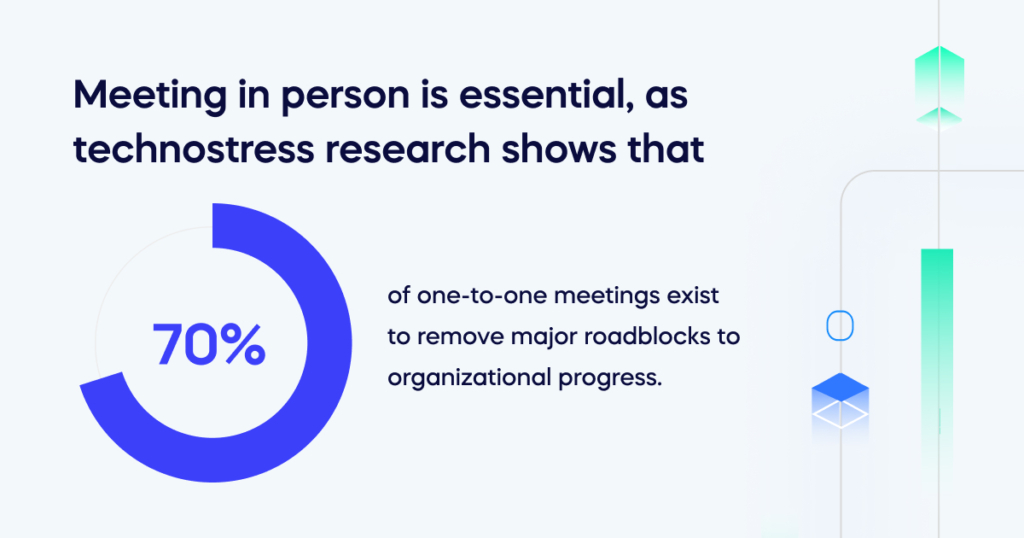
Meeting in person is essential, as technostress research shows that 70% of one-to-one meetings exist to remove major roadblocks to organizational progress.
Overreliance on technology and fewer opportunities to engage face-to-face with colleagues can lead to technostress and a weak organizational culture, negatively impacting productivity and reducing well-being, leading to lower employee retention.
5 types of technostress (with examples)
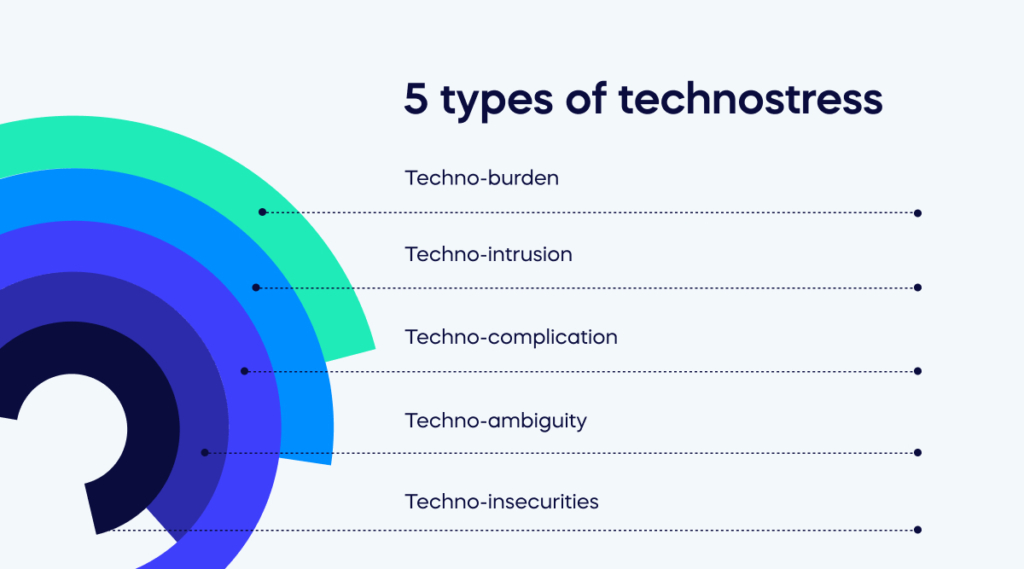
Whether operating remotely or within a physical workspace, five primary sources of work-related technostress exist, beginning with techno-burden.
1. Techno-burden
Employees experience techno-burden when tasked with accomplishing more within confined timeframes, leading to a sense of being inundated by a ceaseless data flow. Doing so results from a barrage of messages and notifications from various origins.
Example
Imagine a manager receiving a project to complete in a limited timeframe. They use technology to speed up the completion through Zoom meetings rather than waiting until staff can meet in person.
The reliance on technology and avoidance of one-to-one meetings causes more stress for the project manager and their team, delaying progress and increasing technostress and sickness absence.
2. Techno-intrusion
Techno-intrusion arises as employees constantly receive expectations to remain “connected,” blurring the boundaries between personal and professional spheres.
It emerges from receiving work-related alerts beyond official hours and the subsequent compulsion to respond promptly. Remote staff often lament their inability to disengage or detach.
Example
Employees use their phones for personal and professional purposes and check their emails too often.
This phenomenon is a common cause of technostress and can lead to sickness absence as employees struggle to separate work and personal life, causing distress that impacts both spheres.
3. Techno-complication
Techno-complication manifests when employees perceive the necessity to possess confidence in technology. Doing so engenders bewilderment and dread of technology and exacts a toll on an employee’s effectiveness.
Example
Many employees have adopted generative AI like ChatGPT, and they find it helpful in completing mundane tasks so they can concentrate on higher-level tasks.
However, seeing others use ChatGPT and other tools can pressure other employees who may not possess the knowledge or confidence to use similar tools.
This environment can create stress and resentment toward colleagues through techno-complication, negatively impacting organizational culture and reducing collaboration.
4. Techno-ambiguity
Techno-ambiguity arises when an employee feels bewildered or uncertain due to the rapid pace of digital transformation.
If a company consistently embraces novel technology or employs software subject to frequent updates, it can be overwhelming for certain employees to stay abreast.
Example
An extensive app portfolio is an excellent example of how techno-ambiguity can manifest.
Too many apps, often with overlapping purposes, can cause technostress as it is challenging to keep up to date with new tools.
This sense of overwhelm can cause distress, resulting in sickness absence, and if it persists, employees may even depart their organization.
5. Techno-insecurities
Techno-insecurities entail employees worrying about potential job or status displacement due to new technology supplanting or reshaping their roles.
Employees persistently sense an obligation to upgrade their technological prowess as they display signs of techno insecurity.
Example
When an organization has a weak employee training program, teams may not feel equipped to fulfill their responsibilities and handle insecure about their role, fearing they may lose their job as their leaders consider them inadequate.
Provide excellent training to all employees, with in-app guidance, to allow them to train as they work, and personalized training enables all staff to avoid techno-insecurities.
They always understand the purpose of new technologies and how to use them to help themselves and their organization excel.
Office-based causes of technostress
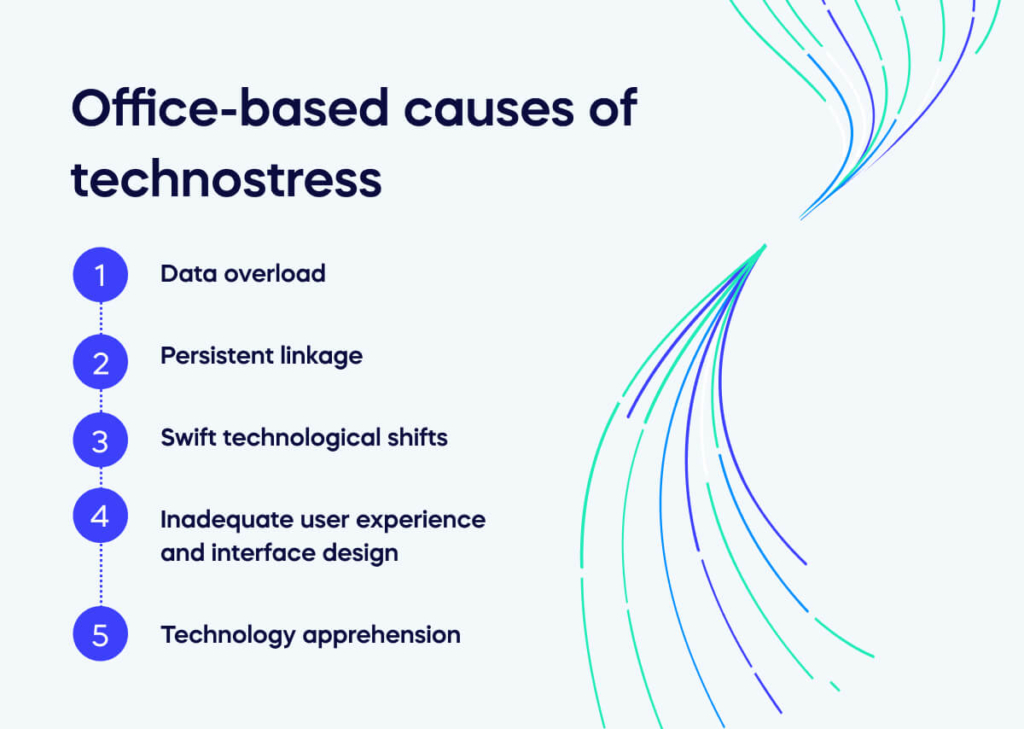
The main reason for technostress is the limited human capacity to manage information. Still, the advancement of new digital tools humans must use in the office workplace is unlimited.
See the list below for the potential origins of office-based technostress:
1. Data overload
Technostress significantly stems from information overload within employee ranks. A continuous influx of notifications, emails, and diverse digital communications obstructs focus and workflow.
The persistent interruptions resulting from techno-overload particularly harm productivity.
2. Persistent linkage
In organizations lacking well-defined technological boundaries, an ongoing need to remain connected and swiftly respond to communications burdens employees.
This constant connectivity, particularly beyond official work hours, generates technostress amidst the workforce.
3. Swift technological shifts
An abrupt technology shift triggers techno-uncertainty among employees in the organization. Coping with the introduction of new workplace technology can induce stress and anxiety.
Companies can introduce digital adoption platforms to alleviate this transition and methodically plan to integrate new technology.
4. Inadequate user experience and interface design
A poorly constructed user interface can bewilder users, provoking frustration and apprehension. Employees might struggle to navigate tasks, eroding productivity.
This action can lead to uncertainty, anxiety, and a sense of being adrift or unsure about subsequent steps.
5. Technology apprehension
Technophobia arises when employees encounter unresponsive, user-unfriendly technology devoid of feedback mechanisms.
Struggling to complete tasks under such conditions fosters technostress among employees.
How does technostress affect remote teams?
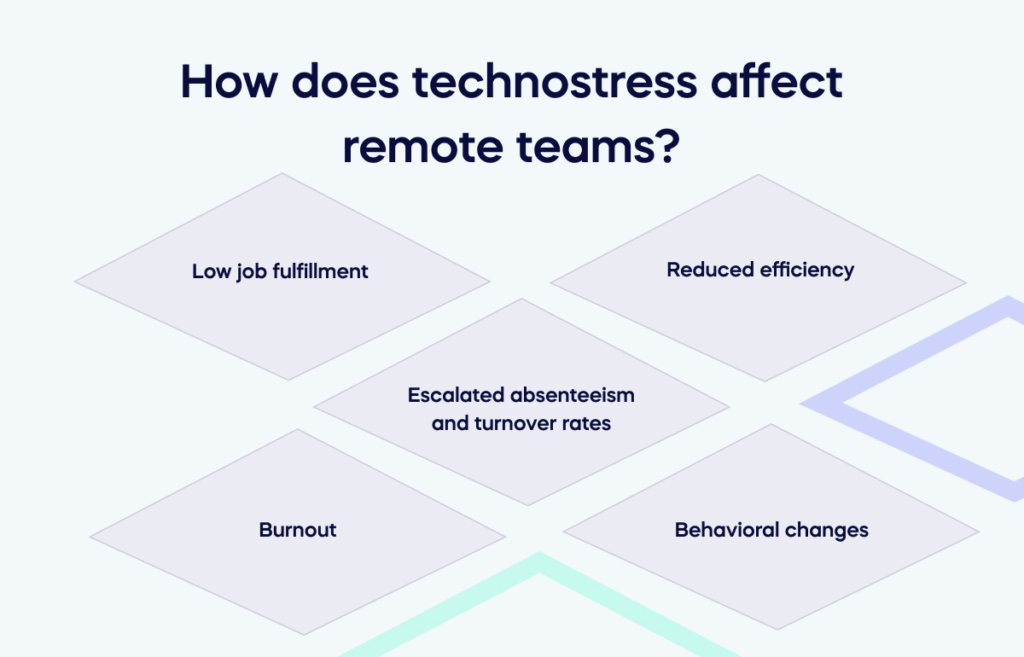
The negative results of technostress include physical effects and work-related problems such as burnout and reduced productivity.
While individual responses vary, recent research identifies several familiar repercussions of technostress in remote teams:
Low job fulfillment
Persistent struggles with the technology they employ generate technostress in employees, fostering frustration and anxiety. This action, in turn, gives rise to workplace clashes, irritability, and a decline in job satisfaction.
Reduced efficiency
Inadequate familiarity with the employed technology slows task completion and impairs employee productivity.
Companies can arrange training sessions and product walk-throughs to address such scenarios to ensure employees are at ease with regularly used technology.
Escalated absenteeism and turnover rates
Technostress can sap employees’ motivation, potentially leading to elevated organizational attrition rates. Consequently, companies must tackle technostress effectively among their workforce.
Burnout
Job burnout manifests when employees experience emotional exhaustion or disillusionment with their work. Numerous studies correlate work-related stress with heightened burnout rates. Remote employees often perceive the need to be “constantly available,” amplifying burnout risks.
Behavioral changes
Technostress can incite behavioral shifts, including diminished initiative and energy levels. A two-year study uncovered that heightened IT demands resulted in cognitive issues such as concentration difficulties, memory lapses, and compromised decision-making.
How to reduce technostress in your organization
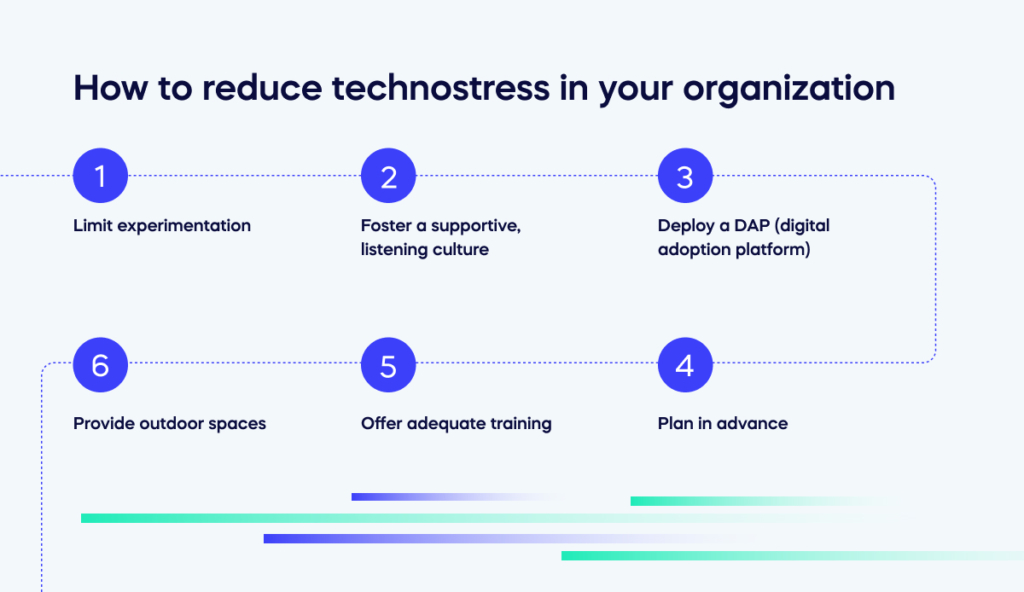
When you deploy new technologies in your organization, you want employees to optimize their use as they learn to use them quickly and within their comfort zone.
However, employees often experience anxiety, leading to panic attacks, prolonged stress, decreased motivation, and burnout.
Follow these best practices to reduce technostress and improve employee productivity and well-being.
Limit experimentation
Introduce the approved technology that works well for the task at hand. Instead of introducing five different technologies, find the one that offers the most features and covers the job of all five technologies, such as a super-app.
Foster a supportive, listening culture
A 2023 academic survey calls organizational culture critical to reducing or eliminating technostress in the tech industry.
The reason is that a culture of listening to team members and ensuring they are the priority, not performance goals, provides that technology is secondary to the well-being of employees, allowing them to be motivated by their organization and perform of their volition.
Respond to this research by fostering a supportive, listening culture where the staff knows who to contact about technostress.
Deploy a DAP (digital adoption platform)
Software paralysis can occur when employees have too many applications with overlapping functions, making them unsure of which app to use for a specific purpose and feel they must learn too many new apps simultaneously.
A DAP (digital adoption platform) helps reduce software paralysis with in-app guidance and personalized training to help staff understand the purpose of each app and identify apps with overlapping functions to report this to IT, reducing waste and an excessive app portfolio that may contribute to technostress.
Plan in advance
Gradually introduce changes and new computer technologies, and be realistic about what’s possible within your digital innovation efforts.
When you plan investment for new technologies, conduct a risk assessment on how it will affect staff and collect employee feedback on how the team feels a new technology would impact their role.
Offer adequate training
Ensure employees receive adequate training to familiarize them with new technologies and time for adjustment to encourage staff to use new tech through understanding why the organization needs it and the incentives for the employee to include it in their workflow.
Provide outdoor spaces
Academic technostress research by Caracuto et al. found that access to natural outdoor spaces reduced the likelihood of technostress in WFH employees. But you could also apply this to larger offices with outdoor areas.
Shift your organizational culture to raise awareness of technostress risks
In summary, the imperative to change organizational culture and elevate awareness regarding the risks of technostress is hugely significant.
Organizations can reap the benefits of a healthier, more resilient workforce by fostering a workplace environment that prioritizes well-being and equipping employees with the knowledge and tools to combat technostress.
This cultural shift safeguards employee mental health and enhances overall productivity and innovation. Embracing change and investing in employee well-being is the key to thriving in the digital age.

